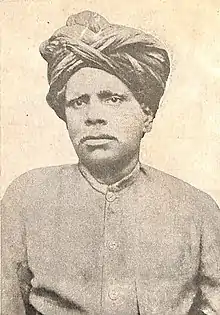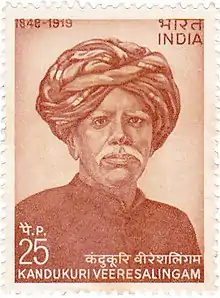Kandukuri Veeresalingam
Rao Bahadur Kandukuri Veeresalingam Pantulu (16 April 1848 – 27 May 1919) was a social reformer and writer from the Madras Presidency, British India. He is considered as the father of the Telugu Renaissance movement. He was one of the early social reformers who encouraged the education of women and the remarriage of widows (which was not supported by society during his time). He also fought against child marriage and the dowry system. He started a school in Dowlaiswaram in 1874.[2] , constructed a temple known as 'Brahmo Mandir' in 1887 and also built the 'Hithakarini School' in 1908 in Andhra Pradesh. His novel Rajasekhara Charitramu is considered to be the first novel in Telugu literature.[3]
Kandukuri Veeresalingam Pantulu | |
|---|---|
 Kandukri Veeresalingam Panthulu | |
| Born | Kandukri Veeresalingam Panthulu 16 April 1848 |
| Died | 27 May 1919 (aged 71) |
| Nationality | Indian |
| Occupation | Social reformer, writer |
| Spouse(s) | Bapamma Rajyalakshmi
(m. 1861) |
He is often considered as the Raja Rammohan Roy of Andhra. He was also known by the title Gadya Tikkana, or ‘the Tikkana of Prose'.[4]
Early life
Kandukuri veeresalingam was born in Rajahmundry, Madras Presidency, to Subbarayudu and Poornamma. When he was six months old, he suffered from smallpox, a dangerous disease during that time, and when aged four his father died. He was adopted by his paternal uncle, Venkataratnam. After studying in an Indian street school, he was later sent to English medium school where his talents were recognised. His good nature and studiousness earned him the best student award in his school. He completed his matriculation in 1869 and got his first job as a teacher in Korangi village.[2]
Literature
Veeresalingam was a scholar in Telugu, Sanskrit, and Hindi. Considering literature as an instrument to fight against social evils, his writings also reflected the same. He wrote plays such as Prahlada (1885), Satya Harischandra (1886).[2] He published a novel Rajashekhara Charita in 1880, originally serialised in Viveka Chandrika from 1878. Generally recognised as the first Telugu novel, it is inspired by The Vicar of Wakefield, a novel by the Irish writer Oliver Goldsmith.[3]
His works include:
- First novel in Telugu 'Rajasekhara Charitra'
- 'Viveka Vardhini' a journal for women education in 1887.
- 'Satihita bodhini' a monthly magazine for women.
- First drama in Telugu and first book in Telugu on sciences & history.
Brahmo Samaj
Kandukuri Veeresalingam was inspired by the principles of Brahmo Samaj leaders like Raja Rammohan Roy, Pandit Ishwar Chandra Vidyasagar, & Maharshi Keshab Chandra Sen. He started his own Brahmo Mandir in Rajahmundry near bridge in 1887.[2]
Social reformer
Welfare of women
One of the greatest reforms of Veeresalingam was to promote women's education, which was considered to be a taboo in those days. In 1876, he started a journal called Viveka Vardhini and published articles about women's issues of that era. The magazine was initially printed at Chennai (then Madras), but with his writings gaining popularity, he established his own press at Rajahmundry.
Remarriage of widows was not appreciated in the society during those days, and he opposed this by arguing that widows were not prohibited from remarrying by quoting verses from the Hindu Dharma Sastra to prove his point. His opponents used to organise special meetings and debates to counter his arguments, and even resorted to physical violence against him when they failed to stop him. Undeterred, Veeresalingam started a Remarriage Association and sent his students all over Andhra Pradesh to find young men willing to marry widows. He arranged the first widow remarriage on 11 December 1881. For his reformist activities, Kandukuri gained attention all over the globe. The Government, in appreciation of his work, conferred on him the title of Rao Bahadur in 1893. Later he established a widow home.[4]
Politics
Kandukuri Veeresalingam served as one of the members of the first Indian National Congress (INC) meeting in 1885.[2]
Personal life
Kandukuri Veeresalingam was married to Bapamma Rajyalakshmi in 1861. At the time of marriage, he was 16 years old, and his wife was 9.[2]
Death

Veeresalingam died on 27 May 1919 at the age of 71. His statue has been unveiled on the Beach Road in Vishakhapatnam.[2] In his memory, the Indian Post department issued 25 paisa postage stamp in 1974.[5]
References
- Arnab, Sengupta (18 December 2013). "Kandukuri Veeresalingam Pantulu (Andhra Social Reformer)". ImportantIndia.com. Important India. Archived from the original on 19 August 2016. Retrieved 20 June 2016.
- Editor, ILoveIndia. "Kandukuri Veeresasilngam Biography". iloveindia.com. iloveindia. Retrieved 20 June 2016.CS1 maint: extra text: authors list (link)
- Sisir Kumar Das (1991). A History of Indian Literature 1800–1910 (Western Impact: Indian Response). New Delhi: Sahitya Akademi. pp. 209–210. ISBN 978-81-7201-006-5. Retrieved 18 April 2018.
- Vepachedu, Srinivasa Rao. "Kandukuri Veeresalingam, Father of Andhra Renaissance". Vepachedu.org. Vepachedu Srinivasa Rao. Retrieved 20 June 2016.
- "Father of renaissance movement in Telugu". Mintage World. 10 May 2019. Retrieved 26 June 2019.
External links
| Wikimedia Commons has media related to Kandukuri Veeresalingam. |